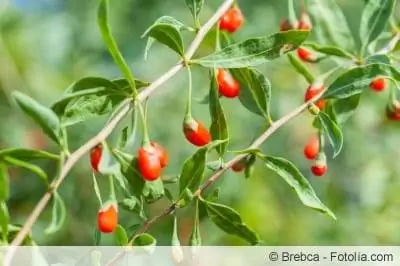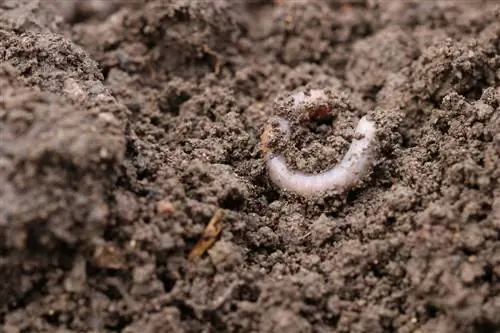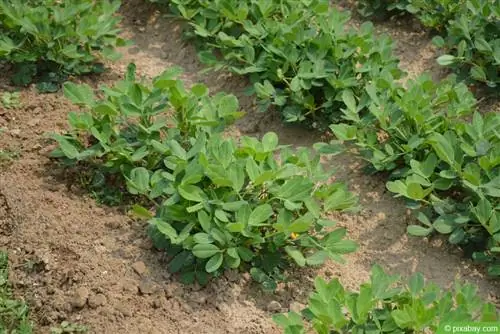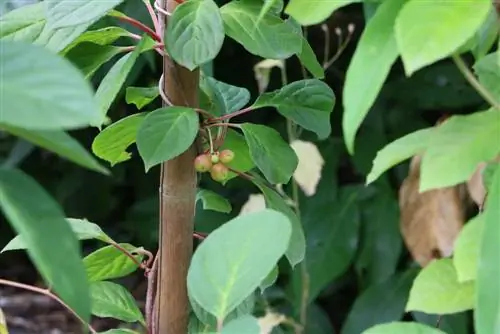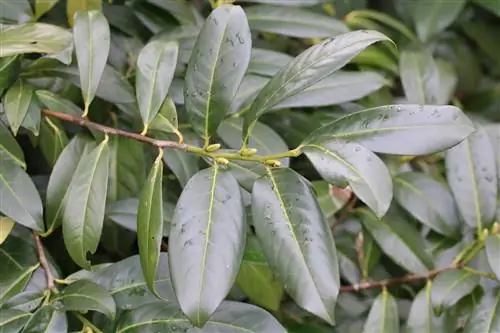- Author admin [email protected].
- Public 2023-12-17 03:39.
- Last modified 2025-01-24 12:45.
Goji berries or Chinese wolfberries, which belong to the nightshade family, are most likely originally native to Asia or southeastern Europe, but have spread to this latitude over the centuries and have adapted to the prevailing weather conditions here adapted to the years. This is why the attractive and, above all, he althy buckthorn is also very popular in local gardens. Because flowers and fruits not only look decorative, the berries can also be used in the kitchen.
Location
If you have decided to cultivate a goji berry, also known as the common buckthorn, in your garden, you need a particularly sunny location for your plants. Even though it is a nightshade plant, which means that the fruits ripen at night in the dark, the plant still needs enough sun and warmth during the day. The location you can choose is either a sunny garden bed or a pot on a sunny terrace or a south-facing balcony. The goji berry has no special requirements here if the wider environment, for example the soil conditions and enough space on all sides, is guaranteed. The following should be taken into account when choosing the location:
- Potted plants should not be exposed to the blazing midday sun in summer
- Plants grown in beds have no problems with this
- Although the plants are hardy, bushes grown in pots still need to be protected in winter
- because the roots in the pot are more vulnerable in winter
- therefore keep the pot indoors in winter or protect it with plant fleece around the pot and place it on a polystyrene plate
- Plants cultivated in the garden bed can be left without protection in winter
Sowing
Goji berries can be sown very easily, but it should be borne in mind that the red fruits will only be harvested after several years. A distinction must be made here that potted plants can bear fruit after just one to two years, while plants in the garden bed need three to four years to do so. But the buckthorn is suitable as an ornamental shrub from the first year onwards, even if it is still a very small plant that, with appropriate care, can grow into a stately bush of up to four meters over the years. When sowing, the following should be taken into account:
- The seeds are sown in small pots in early spring from around the beginning of March
- The cultivation pots can have their place in the warm apartment or a winter garden
- A bright, south-facing window sill is suitable for this, for example
- A germination temperature of around 20° to 25° Celsius is ideal
- Since waterlogging should be avoided, cultivation pots with holes in the bottom are recommended, which are placed in a cultivation tray
- In this way the drained water can be poured off
- coconut fiber or commercial potting soil is required for sowing
- The seeds are pressed deep into this after spending the previous night in room temperature water
- Cover pots with translucent foil
- to avoid mold formation on the ground, ventilate regularly
- Keep seedlings moist but not too wet
- after about two to six weeks the first tender plants appear
- Prick out and place in your own pots
Tip:
The seeds should be of high quality; the seeds from the real goji berry, Lycium barbarum, have proven to be suitable for your own cultivation.

Plants
The goji berries are planted outside in the garden bed or in a bucket on the terrace after the last frost, ideally after the Ice Saints in May. Even if the plant is hardy, a final night frost can be harmful to the young bushes that have just emerged. If you want to be on the safe side, keep the seedlings in the house or in the winter garden for as long as possible. If the buckthorn is cultivated in a bucket for a location on a terrace or balcony, drainage must be placed over the drainage holes. This can consist of pottery shards or stones over which a plant fleece is placed. The soil for the pots should consist of commercially available potting soil and perlite or sand to ensure water permeability. The drainage created prevents waterlogging. When planting in the garden bed, proceed as follows:
- If several bushes are cultivated or they are next to other plants, make sure there is enough space
- Goji berries not only grow tall but also wide
- can grow up to four meters high without pruning
- Dig planting hole and prepare soil
- mix with sand or perlite to give permeability
- create drainage at the bottom of the planting hole
- Use young, home-grown or commercially purchased goji berries
- Fill up the soil and press it lightly
- water and fertilize regularly
- In this way, the hobby gardener quickly gets a stately bush
Tip:
Larger and older plants purchased from stores can be transplanted into a garden bed or a pot at any time.
Propagate by lowering
Goji berries have a habit of self-propagating. Longer branches descend, reminiscent of a weeping willow. Roots form when the branches come into contact with the ground. Hobby gardeners who do not want to propagate their existing goji berries must ensure that the branches do not hang too far down and tie them up over the summer months. This means that berries can still form on these shoots. But the sinkers can be used well for propagation. The procedure is as follows:
- bury long branches for support so that they can form roots
- use tent pegs to hold the branch in the ground
- as soon as the roots have become strong enough, the shoots are separated from the old branch
- Since the sinkers are usually too close to old plants, they have to be carefully dug out
- The new plants obtained in this way find a new location in the garden or in the pot that offers them plenty of space
Tip:
If lowering branches are to be used for propagation, then some of the branches growing down must not be tied up or cut, but remain hanging until they have used the connection to the ground for root formation.
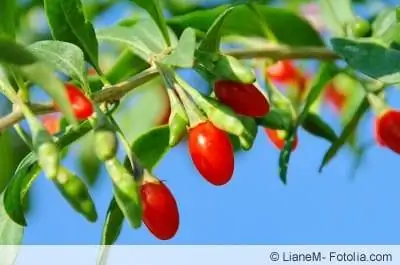
Propagate by cuttings
If the goji berry needs pruning, branches of it can be used for propagation through cuttings. To do this, approximately 15 centimeters long cuttings are inserted up to 5 centimeters deep into a pot with potting soil and watered. After a short time, roots form and the first leaves and new shoots appear. The cutting must be watered regularly without being exposed to waterlogging. A sunny and warm location is also ideal for this method of propagation. If no frost is expected in the near future, the newly obtained plant can be planted in the garden bed. Cuttings for pot cultivation can be inserted there right from the start.
Substrate & Soil
The ideal soil for goji berries is permeable. The attractive shrub also accepts sandy soil. However, if the soil at the desired location only offers low water permeability, it should be prepared. Proceed as follows:
- Create drainage in the lower area of the planting hole made of stones
- Mix in soil, compost, bark mulch, sand or perlite to make it more permeable
Tip:
Goji berries are often planted by communities on the median strip of highways because the shrub can cope well with light amounts of s alt. This is especially good to know for the winter if the ornamental plant was grown in the garden next to a path.
Conclusion
Goji berries are very suitable for cultivation in local gardens and front gardens, but also on a sun-drenched terrace or a south-facing balcony. Because the very hardy nightshade plants can also be easily cut to the desired size as a container plant. They thank the hobby gardener for a sunny location with a rich harvest of their tasty and he althy fruits. The bushes can easily be grown from seeds yourself; if you want a quicker harvest, you can plant small bushes from the nursery. Hobby gardeners who already have one or two buckthorn can also propagate them using cuttings or cuttings.

